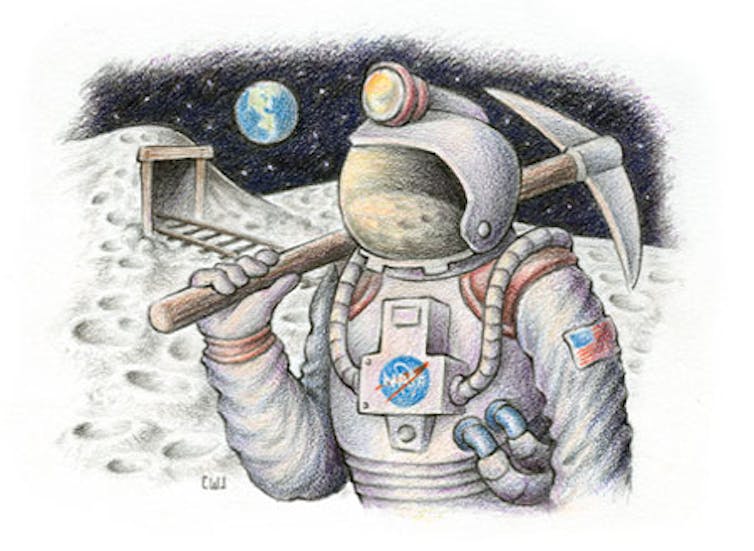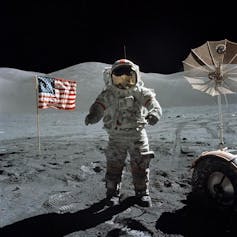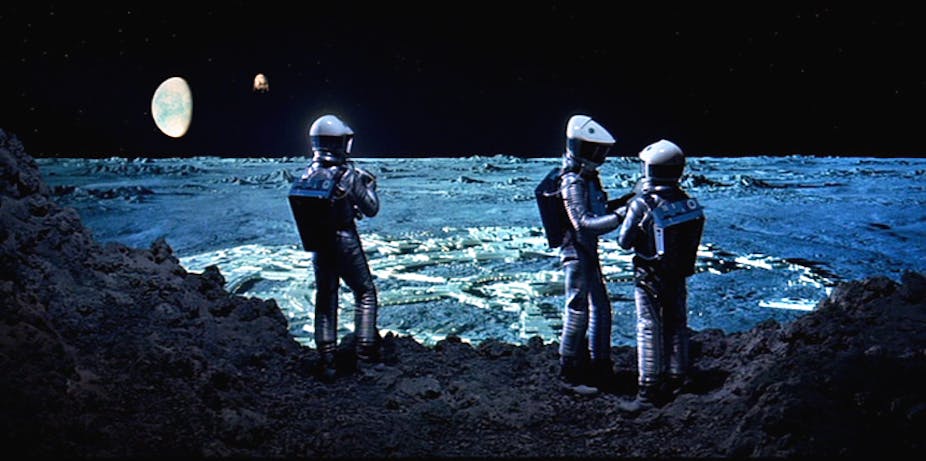As history has repeatedly shown, where there are valuable minerals to be unearthed, adventurous humans will arrive in droves – even if it means battling extreme conditions and risking life and limb.
So what will happen when the next great “gold rush” in our history is quite literally out of this world? And what kind of technology would be needed for the mining? After many years of trying, I believe a have a workable answer to the second of these questions – but what about the first?
Business analysts may poke fun at the “impossibly” expensive cost of mining nearby celestial bodies such as asteroids, or even the moon, but these pursuits are not beyond the realm of possibility.
Returning to the moon for the purposes of mining will require new technologies and new ways of thinking, and this extends to the conventional business model. We cannot write these pursuits off based on high cost alone, especially given the hidden treasures to be found.

Rare-earths, off the earth
Demand for “rare-earth” minerals (which are used in a range of technologies) is rising sharply, but their supply is extremely limited.
It is estimated that China is producing and storing roughly 95% of the world’s present demand and, in recent times, has expressed an unwillingness to share the wealth by imposing export bans.
While most people have never heard the exotic names Yttrium, Lanthanum, and Samarium, these rare-earths are increasingly critical in the making of high-tech products with both civilian and military applications. Technologies ranging from tablets to missiles to wind turbines all require these valuable minerals, all of which are available in abundance on the moon.
Helium-3 (He-3), a non-radioactive nuclear fusion fuel, considered by some to be the safe energy source of the future, is also abundant on the moon.
It is presently available on Earth but costs approximately A$5,000 per litre and the energy required for extraction and processing exceeds the energy that can be gained from the fusion reactor.
In other words, it’s not economically viable. But easy access to more plentiful reserves will change this equation.
While each of these minerals alone might not provide a viable return-on-investment (ROI) their unique distribution on the lunar surface creates the opportunity to “split-the-cost”.
In other words, if designed properly, many rare-earth minerals and He-3 could be mined with the same equipment, at the same location using the same “Earth-to-Moon” shuttle – a commercial vehicle that could ferry materials back down to Earth.
This shuttle could use lunar oxygen or hydrogen as a fuel – another cost-saving approach. In other words, the “petrol” station should be on the moon and not on Earth.
So, will we ever see mining trucks hauling material on the moon or on the asteroids? Quite simply, no.
It is a common mistake made by engineers, including myself, to project terrestrial technology on to the moon. After all, the moon’s environment is vastly different to that of Earth.
The moon is not the earth
Over the past 5,000 years, mining and construction methods have been optimised to fit key parameters on Earth, including the presence of:
- a gravitational acceleration of 9.8 metres per second squared (m/s2)
- an atmosphere of roughly 79% nitrogen, 20% oxygen and 1% other gases
- water
- soils containing clay, sand and gravel
- plants and timber
None of the above conditions is replicated on the moon or on asteroids, yet we are so caught up in earthly-thinking that it’s extremely difficult to consider the synergistic effect of several key factors being changed at the same time.
Let’s take gravitational acceleration that changes from 9.8m/s2 to 1.6m/s2 when we go from the earth to the moon. This has a drastic effect on excavation.
Gravity creates traction for the tyres, which is required during digging or as a counter-weight to keep equipment from toppling over.
In order to achieve the same amount of digging force or ballast weight on the moon a mass six times that on Earth is needed. This creates an immediate dilemma, as the cost of transporting conventional equipment to the moon would be, as analysts suggest, prohibitively expensive.
One kilogram delivered to the moon costs (today) approximately A$25,000. So, a small 3.3-metre-long skid-steer loader with a terrestrial weight of 2,500kg would need to weigh 15,000kg at launch. This would lead to a transportation cost of A$375 million.
And that’s not considering the trucks we’d need to take up to the moon to move the soil around.

The key feature that eliminates earthly loaders and trucks as viable options for lunar mining, and one that most definitely cannot be overlooked, is their dependence on dust-producing wheels.
Lunar dust, as highlighted by the Apollo missions, is pesky and potentially hazardous for spacewalkers and robotic equipment.
On the moon, the lack of an atmosphere, the low gravity and the small soil particles allows the sun to energise the soil enough so the particles stay levitated after being kicked up by a shoe, truck tire or a loader bucket.
This is just one reason space-engineers must drop all Earth-bound pre-conceptions. In the 25 years I’ve been thinking about lunar mining and construction, I’ve found that this “dropping” is not easy to do.
It requires us to replace all earthly principles and constraints; a process I call “synergy-n engineering”.
The term expresses a process where 1 or n key engineering factors, synergistically optimised for an Earth design (mining or construction, for instance), are substituted, each impacting all the others.
One can easily see that the complexity of space engineering raises exponentially more factors as those mentioned above (one to five) are adjusted to fit the lunar environment.
I believe that after many years of experimental work in small laboratories I have come up with a mining technology that fits the lunar condition: suction extraction with pneumatic transportation.
This technology uses airflow, much like water, to transport material that is small enough it can be sucked by a Venturi process, into a pipe and transported from a high-pressure entry to a low pressure exit point.

I need to add a caveat here in that I have not tested this technology (yet) in the lunar environment. Still, it requires a minimal mass to be launched to the moon as it relies heavily on in-situ resource utilisation (ISRU).
So, rather than transporting pipes for moving minerals, my concept would use the readily available silicates and the solar heat energy available on the moon to manufacture and join glass pipes on site.
This is one cost-saving mechanism: relying on materials that are already available. It’s similar to how the First Fleet relied on fresh water, trees and stones to build houses, barracks and bridges in what would become Sydney.
A second critical feature of our mining process is that it’s a dust-free operation. Gene Cernan, a lunar astronaut on Apollo 17, highlighted my apprehension about creating dust when he said: “I think dust is probably one of our greatest inhibitors to a nominal operation on the moon.”
Finally, extracting and transporting the lunar soil to the processing plant is highly efficient as it utilises the lower lunar gravity as well as its dry and powdery characteristic as a resource. In this way, we would minimise the energy required to operate a lunar mine.
There is obviously much work still to be done, and many naysayers to convince, but it’s not a pipe-dream without proponents.
Some investors forecast lunar mining will start by 2016. Mining on asteroids, some analysts believe, will have to wait in line until 2022.
Time will tell how these plans will be realised but there is no question that mining on the moon and asteroids will eventually happen.

